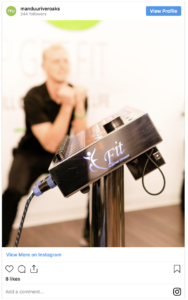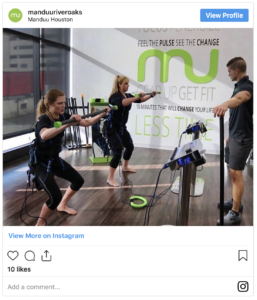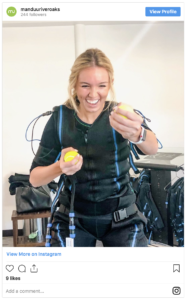Online Story Featured on Houstoniamag.com
WHAT IF YOU COULD ACCOMPLISH six hours of strength training in 15 minutes? Before you write it off as too good to be true, know this: It requires an electrical current.

It’s a science used frequently in rehabilitative physical therapy, where the technique is commonly referred to as “e-stim,” because it allows for targeted muscle penetration. More recently, though, its application has expanded beyond medicine, with some research suggesting EMS can help athletes both train and recover. And if it can help athletes, logic follows, can’t it also help regular, healthy people?
Manduu, an EMS fitness franchise, says yes. The Nashville-based company operates 10 studios around the country, including its most recent addition right here in Houston. The River Oaks studio, which opened last month, joins Austin and Dallas locations as the third Manduu in Texas.
The FDA recently cleared EMS for non-medical exercise settings—opening a path for businesses like Manduu—but still refutes that any device can lead to weight loss (which is not actually a claim Manduu makes, to be fair). All parties instead focus on building strength: The FDA says “an EMS device may be used to temporarily strengthen, tone, or firm a muscle.” That definitely doesn’t mean you’ll end up with rock-hard abs—and definitely not overnight—but some research shows people who use EMS training are more likely to take on increased exercise as their muscles become better equipped for activity.
While unique, Manduu isn’t exactly revolutionary: Some people had a similar idea in the ’50s with the thoroughly midcentury-named “Relax-a-Cizor,” a wearable EMS unit marketed for fitness. This was pre-FDA regulation—actually, it’s what spurred FDA regulation—and users were directed to place up to 12 electrodes on their body to receive 40 muscular contractions a minute for at least 30 minutes a day in each problem area.
For contrast, experienced Manduu clients max out at two 15-minute sessions per week; beginners start at just once weekly.
The Relax-a-Cizor was banned in 1970.
So, take heart, this isn’t that. At Manduu, a trained professional monitors each private session—your first one is always free—which begins with an InBody scan that reports a series of biometrics, from body fat percentage to resting metabolic rate, via a very fancy scale. It’s meant to give you a comprehensive picture of your current state, presumably so you can monitor your progress (a trainer will analyze your results at the end of the workout). In our experience, it’s not for the faint of heart.
But before you get to learn that, say, roughly half of your person is somehow fat, you get to actually experience the EMS. First, you suit up in Manduu-issued workout gear—not terribly unlike a Scuba suit—fitted with carbon-fiber electrodes. and a series of electrodes. Don’t be alarmed when your trainer sprays you; wetting down the suit’s electrodes makes you more conducive.
Next, you’ll be plugged into a battery-operated machine that looks like a torture device but, you are assured, doesn’t actually contain enough electricity to hurt you. Its many dials are monitored and adjusted by the trainer, who leads you through a series of stretches and basic movements while slowly upping the electrical current to find your threshold at each body part—biceps, triceps, pecs, abs, glutes, and quads.
Then, the workout begins. It’s low-impact and deceptively easy—are we sure we’re working out, or are we still stretching?—until the trainer starts upping the electricity. The pulses feel like tingles, then verge on pain as they intensify. It doesn’t hurt, but it feels like what it is—every fiber of your muscle jolting awake and into action for the first time that day.
The pulses come in intervals, and, as you start to get the hang of it—remembering to never lock your knees, squeezing a tennis ball in each hand, and timing your breathing to each contraction—the trainer challenges you to take on more resistance. It feels like you’re doing so much more than simply squatting, lunging, and reaching overhead. The arms are the hardest.
But just like that, it’s over. Fifteen minutes flies by, and it’s time to disrobe and dry off. The trainer warns you that, much like Pilates, you’ll likely feel this a little bit tomorrow, but you’ll really feel it the day after.
She’s right. You worked out (though you’re still not convinced it’s fair to even call it that) on Wednesday; by Thursday, it hurts a bit to laugh; by Friday, you can barely raise your arms to put your shirt on. Any lingering doubt that this low-level electrical current didn’t really do anything vanishes when you try to climb the stairs.
Feeling like you did seven million crunches when in reality you did, like, 10 has to mean something very good is happening, right? It’s at this point that you consider returning twice a week, only to realize that whole “15 minutes, so convenient!” thing comes at a premium: $69 per session if you book 15 at a time.
You’re totally broke, but that burn is so good…wait a minute, are there any Relax-a-Cizors laying around somewhere?
Manduu River Oaks, 3733 Westheimer Rd., Suite 5.

